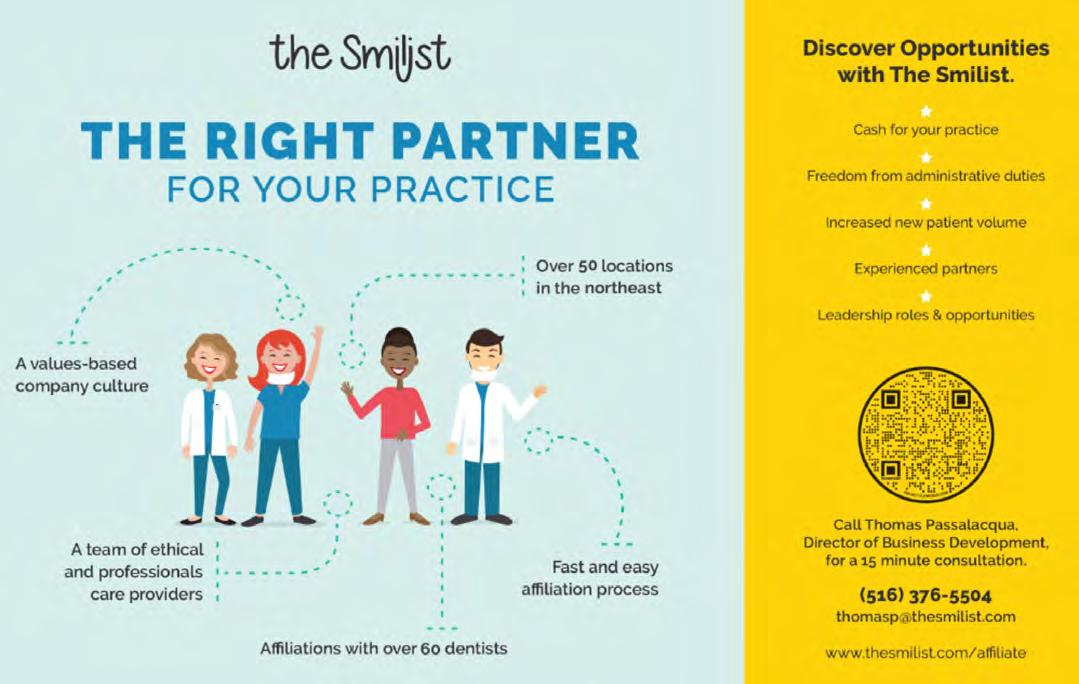
9 minute read
Attorney on Law
Three New Actions Enter Legal Landscape
Latest legal maneuvers cover a variety of fronts with potential impact on dental practices.
Lance Plunkett, J.D., LL.M.
The latest legal developments come from the New York State Legislature, as part of the State Budget; from New York City, on the antidiscrimination front; and from the National Labor Relations Board (NLRB) weighing in on employment law.
As part of the State Budget signed into law by Gov. Hochul on May 3, the Legislature created a new process for reporting “material transactions” entered into by healthcare entities to the New York State Department of Health. The provisions of the law are contained in a new Article 45-A of the New York State Public Health Law. The law takes effect Aug. 1. Whether the law will apply to dental practice entities is ambiguous. Section 4550(2) of the Public Health Law provides:
2. “Health care entity” shall include but not be limited to a physician practice, group, or management services organization or similar entity providing all or substantially all of the administrative or management services under contract with one or more physician practices, provider-sponsored organization, health insurance plan, or any other kind of health care facility, organization or plan providing health care services in this state; provided, however, that a “health care entity” shall not include an insurer authorized to do business in this state, or a pharmacy
benefit manager registered or licensed in this state. An “insurer” shall not include non-insurance subsidiaries and affiliated entities of insurance companies regulated under the insurance law or this chapter. While the law specifically mentions only physician practices (and other entities that clearly are not dental practices), the stem of the law uses the term “shall include but not be limited to.” This opens the door to the Department of Health bringing in other private professional healthcare practices through implementing regulations. However, the law also creates an exception to the reporting requirement for “de minimis” transactions, which are defined to be “a transaction or a series of related transactions which result in a health care entity increasing its total gross in-state revenues by less than twenty-five million dollars.” That exception would probably exclude many private dental practice transactions even if they were included as an entity required to report.
A “material transaction” required to be reported is defined to be any of the following:
1. A merger with a healthcare entity.
2. An acquisition of one or more healthcare entities, including but not limited to the assignment, sale or other conveyance of assets, voting securities, membership, or partnership interest or the transfer of control.
3. An affiliation agreement or contract formed between a healthcare entity and another person.
4. The formation of a partnership, joint venture, accountable care organization, parent organization, or management services organization for the purpose of administering contracts with health plans, third-party administrators, pharmacy benefit managers or healthcare providers, as prescribed by the commissioner by regulation.
What will be required if dental practice transactions are required to be reported? All the following items would need to be reported to the Department of Health by written notice at least 30 days before the closing of the transaction:
1. Names and addresses of the parties.
2. Copies of any definitive agreements governing the transaction, including pre- and post-closing conditions.
3. Identification of all locations where healthcare services are currently provided by each party and the revenue generated in New York State from such locations.
4. Any plans to reduce or eliminate services and/or participation in specific plan networks.
5. The closing date of the transaction.
6. A brief description of the nature and purpose of the proposed transaction, including the anticipated impact of the transaction on cost, quality, access, health equity and competition in the impacted markets, which impact may be supported by data and a formal market impact analysis, and any commitments by the healthcare entity to address such anticipated impacts.
The law is only a reporting requirement. The governor’s original idea of requiring Department of Health approval for all such transactions was rejected by the Legislature. Nevertheless, there are penalties for failing to report. Entities that fail to provide written notice of a material transaction are subject to a daily civil penalty of up to $2,000 for each day the entity has failed to comply. This penalty increases to a maximum of $5,000 per day for subsequent violations that represent a “serious threat to the health and safety” of individuals. There is no cap on the total penalty that may be incurred for failure to provide required written notice, so it does not pay to engage in endless delay.
The new law is odd in that the Department of Health will make the information reported public by both providing any filings submitted to the New York State Attorney General and by publishing information about the transaction on the Department of Health website asking for comment by the public. This type of law is becoming a trend in other states. While not the first to adopt such a law, New York is still an early adopter among the states.
Tear Down those Fences
Also in the State Budget is a new law—Section 394-g of the New York State General Business Law—that prohibits a practice known as healthcare “geofencing.”
Geofencing in healthcare is an advertising mechanism that allows someone to create a digital boundary around a specific healthcare facility and then deliver location-based advertising to healthcare providers or patients who enter the facility by using their location data. The new law prohibits setting up a geofence around a healthcare facility except if it is your own facility. The law takes effect on July 2.

Fit for the Job
On May 26, New York City Mayor Eric Adams signed into law— Intro. #209-A—prohibitions on employers discriminating against persons based on weight or height. The law will take effect on Nov. 22. The new law makes it illegal to take the following actions against any persons based on their height, weight or perceived height or weight:
1. Representing that any employment or position is not available when, in fact, it is available.
2. Refusing to hire or employ or barring or discharging from employment such person.
3. Discriminating against such person in compensation or in term, conditions or privileges of employment.
This type of law, too, is becoming a trend nationally and New York State is considering a statewide law, although New York City has acted first. It should be noted that the city of Binghamton was the first place to enact such a law in New York, in 2008. It has taken a long time for another locality to act.
The New York City law allows exceptions where persons’ height or weight would prevent them from performing the essential functions of a particular job with or without an accommodation, or where the employer’s consideration of height or weight criteria is reasonably necessary for the normal operation of the business. These exceptions will likely be construed narrowly because the New York City Commission on Human Rights is going to define specific jobs and/or job categories that are exempt from the new law. Beyond those listed exemptions, others are going to be difficult to justify and obtain.
NLRB Not Waiting Around
Finally, the National Labor Relations Board (NLRB) has jumped headfirst into the issue of non-compete agreements. Without waiting for any regulations of the Federal Trade Commission (FTC) to be adopted (those are still under review by the FTC), on May 30, the general counsel for the NLRB issued Memorandum
GC 23-08 stating that non-compete agreements violate the National Labor Relations Act (which applies to nearly all employers).
Specifically, the general counsel found that non-compete agreements interfere with employees’ exercise of rights under Section 7 of the National Labor Relations Act (NLRA) and that, except in limited circumstances, the proffer, maintenance and enforcement of such agreements violate Section 8(a)(1) of the NLRA. Section 7 of the NLRA protects employees’ “right to selforganization, to form, join, or assist labor organizations, to bargain collectively through representatives of their own choosing, and to engage in other concerted activities for the purpose of collective bargaining or other mutual aid or protection.”
It is an unfair labor practice in violation of Section 8(a)(1) of the NLRA for an employer “to interfere with, restrain, or coerce employees in the exercise of the rights guaranteed in section 7.” Noncompete provisions are overbroad, that is, they reasonably tend to chill employees in the exercise of NLRA Section 7 rights, when the provisions could reasonably be construed by employees to deny them the ability to quit or change jobs by cutting off their access to other employment opportunities that they are qualified for based on their experience, aptitudes and preferences as to type and location of work.

Generally speaking, this denial of access to employment opportunities chills employees from engaging in NLRA Section 7 activity because:
1. Employees know that they will have greater difficulty replacing their lost income if they are discharged for exercising their statutory rights to organize and act together to improve working conditions.
2. Employees’ bargaining power is undermined in the context of lockouts, strikes and other labor disputes.
3. An employer’s former employees are unlikely to reunite at a local competitor’s workplace and, thus, be unable to leverage their prior relationships—and the communication and solidarity engendered thereby—to encourage each other to exercise their rights to improve working conditions in their new workplace. While the NLRB general counsel memorandum does not have the force of law in the way a statute or regulation has, it is a good guide to how the NLRB intends to act on complaints about non-compete agreements that they may receive.
The federal assault on non-compete agreements is in full swing and New York State also has pending legislation to accomplish the same basic goal, but there has been no result on its fate as of the writing of this article.
Watch for more employment law developments in the coming months at all levels of government. p
The material contained in this column is informational only and does not constitute legal advice. For specific questions, dentists should contact their own attorney.

